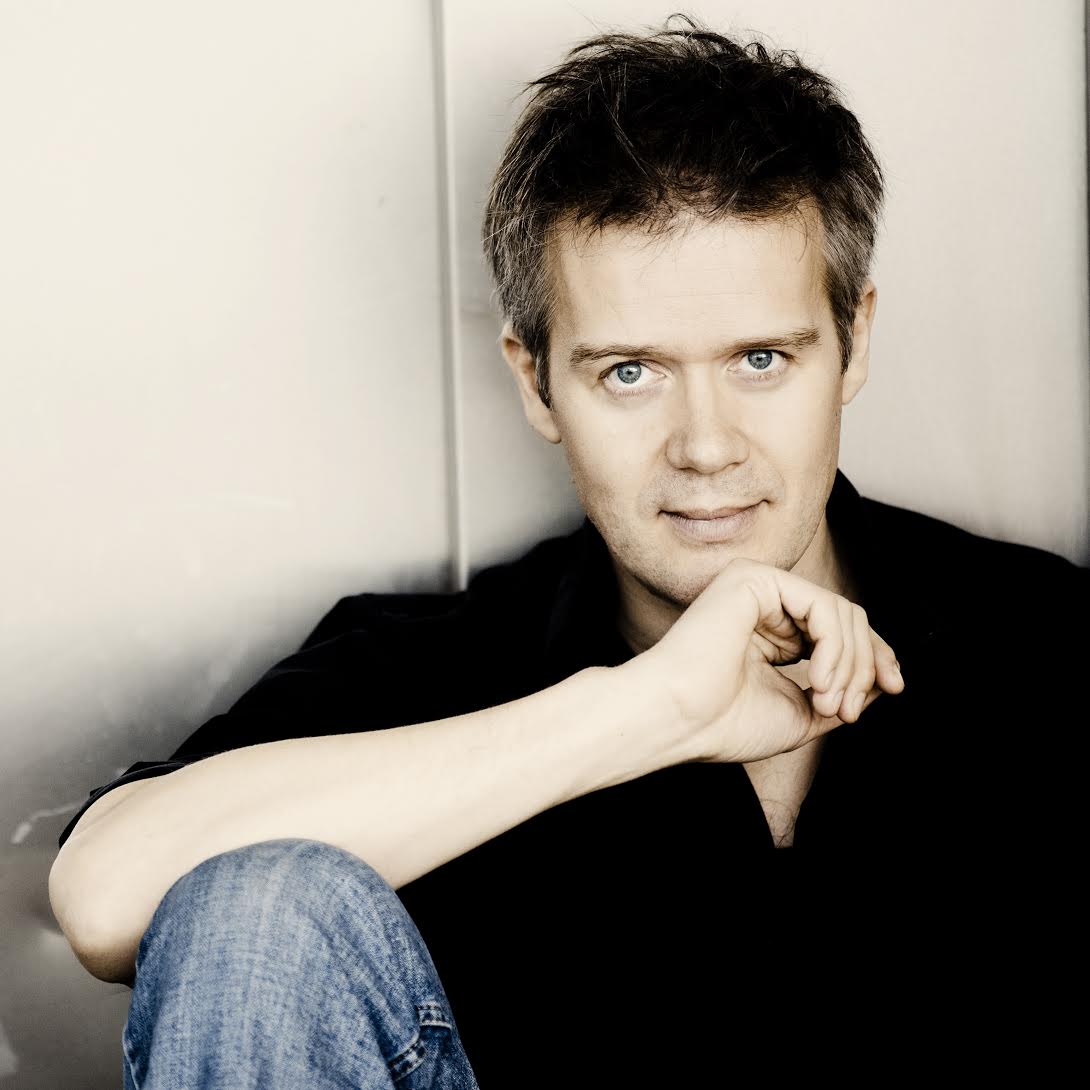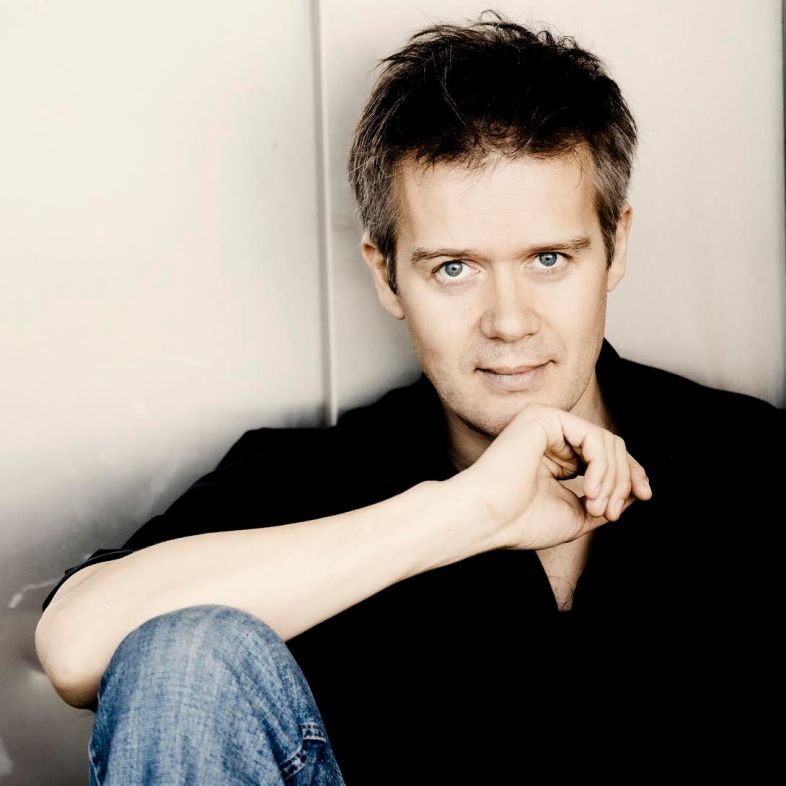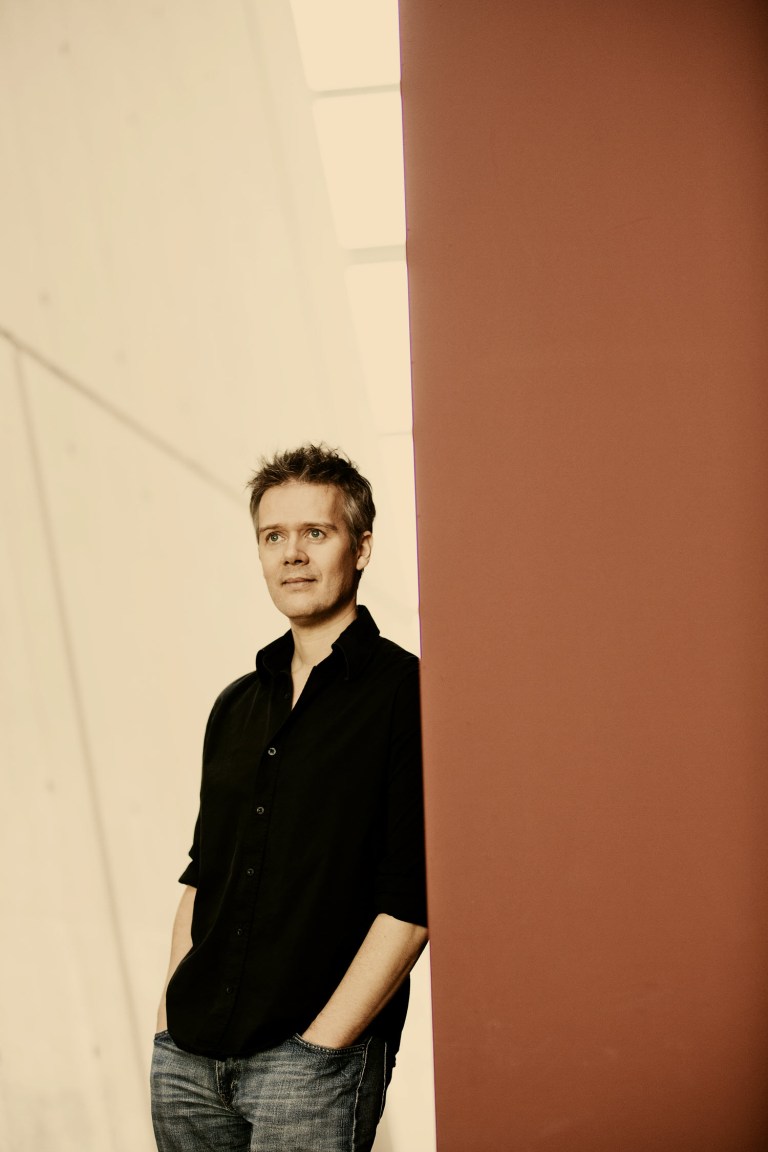Music For Writers: Michel van der Aa’s ‘Hovering’ Flight
Prescribed music as a boy to curtail his nightmares, Michel van der Aa today is one of Europe's most compelling auteurs. His newly recorded Violin Concerto lives, he tells us in Music for Writers, in the performance of Janine Jansen. "She grabs you by the collar."


‘I’m An Art Omnivore’
She meets herself again and again and again. Indeed there are three of her. There appear to be three vertically accessed underground structures, as in a shallow Hugh Howey Wool silo. Above it all, a treacherous desert’s dunes, hot, inescapable, a distant sea glimmering, the Gran Canaria of your worst dreams.
I’m a little torn here because while I want to introduce you quickly to the terrific new violin concerto of Dutch composer Michel van der Aa — thanks to New York Public Radio’s Q2 Music, it’s available to us as Album of the Week. And I also want to call your attention to an eerie, writerly new creation from him, The Book of Sand, just launched. So what I’ll do is give you a brief bit about The Book of Sand, and then we’ll go on with our interview with Van der Aa for his newly recorded concerto. And then I’ll circle back in a subsequent piece here at Thought Catalog with more on Sand. As it is, I want to put a few more questions to him about it.
Michel van der Aa
So, quickly: The Book of Sand is being called an “endless” digital interactive song cycle. And its structure lets you click on any one of its vertical three levels at any time in order to create your own mix. Based in work of Jorge Luis Borges, Van der Aa’s song cycle matches the original story’s sense of there being no beginning. no end. The female protagonist, played by Kate Miller-Heidke, cannot escape — but also cannot rest. A kind of updated, nightmarish Huis Clos, something of its horror is captured in the beginning of the libretto:
It is true that I never leave my house,
but it is also true that its doors
whose numbers are infinite
are open day and night.
Here is an iOS app version, if you’d rather experience Sand that way than on its Web site (I recommend the site).
And, as abrupt as it seems, I’m going to leave you with the teaser below for now, and then return to the full work in a specific look at The Book of Sand. There’s a good chance I’ll be able to tell you about a new Van der Aa work for next season then, too. Keep in mind what he tells us shortly about how he works: “I’m an art omnivore.”
And so, more to come. Now, to the music at hand.
[vimeo 129251328 w=500 h=281]
‘The Darker Aspects Of Life’
Like one of my favorite artists and friends, the music-theater virtuoso Martha Clarke, Van der Aa trades deliberately in what you’ll see him call in our interview “the darker aspects of life.” As a kid, we learn, he got into music on a psychologist’s advice, to channel his energy away from his nightmares.
Van der Aa’s art teeters on the unnerving edges of life. Like Clarke, he has an alchemist’s gift for text, music, light, shadow, electronics and movement that can set fears and disturbances spinning in awful beauty with what appears to be effortless agility. Like an actor, however, he’s thrilled with sky-high energy. This guy’s music and visual worlds rock with power.
Van der Aa is much more than a composer. He’s an auteur, a stage and screen director whose new (November 2014) Violin Concerto is a perfect introduction to the tumbling, tumultuous dynamics of this creator’s imagination.
 Be sure to take advantage of Q2 Music’s Album of the Week opportunity to listen to its recording by the Royal Concertgebouw Orchestra (RCO) under the direction of the meticulous Vladimir Jurowski and led by violinist Janine Jansen as you read through our interview. The second, third, and fourth tracks on the album Horizon 6 from the RCO are his concerto.
Be sure to take advantage of Q2 Music’s Album of the Week opportunity to listen to its recording by the Royal Concertgebouw Orchestra (RCO) under the direction of the meticulous Vladimir Jurowski and led by violinist Janine Jansen as you read through our interview. The second, third, and fourth tracks on the album Horizon 6 from the RCO are his concerto.
The rest of the album is strong, as well. I’m particularly fond of Luc Brewaeys‘ shining Along the Shores of Lorn, the sixth track. This CD is the sixth installment in the RCO’s long-running program of “Horizon” collections of the sort of contemporary classical music that makes Q2 Music such an important resource for writers.
Van der Aa’s work runs from what may be his best-known screen work in some quarters, the film-opera Sunken Garden to chamber music, ensemble works, orchestral pieces, and work for film and movement (the category in which The Book of Sand, for example, resides in his catalog).
Prolific and versatile, there’s an inquisitive quality to all he touches. Always, you can tell he wants to learn something, discover something, uncover something. Like an author who has seized on the right concept, Van der Aa’s execution in many of his works is boldly authoritative. Concepts and their interpretations seem to arrive integrated in his mind. You hear that in the spacious orchestrations of his violin concerto: a latter-day Berlioz, he’s a colorist of thin air, his aesthetics never stop at the sound. Notice that he places his percussionists onstage in a unique way, “because of how it looks.”
‘Lines Of Transmission’
Thought Catalog: Michel, I’m intrigued by the gorgeous, almost pained, quiet opening with the violin completely alone in both your first and second movements of the concerto. Can you say whether there is, in your considerations, a “role” here for the violin, a personality? Or is this “pure sound” in your sense of it?

Image: Marco Borggreve
Michel van der Aa: Yes this was one of the first ideas I had for the piece. I wanted Janine [violinist Janine Jansen] to start alone in the first two movements and hover over the orchestra like a hang-glider before diving down and engaging with the other players.
In the third movement she’s initially squashed in with the orchestra (like a mosquito briefly flying in your ear), and then she breaks free.
TC: Is the piece composed for Janine? And does this rendition of the violin’s lead accomplish what you had hoped it would?
MvdA: I never write solely for an ‘instrument’ but always for a certain performer. Janine is the inspiration and reason I wrote this piece, she’s amazing. She has this unique quality of utter technical perfection combined with a very instinctive, humanistic way of playing. She’s also a wonderful communicator on stage, very theatrical. She grabs you by the collar from the moment she enters the stage. You have to look at her and listen to her, she’s the portal to the music. If Janine had played the ukulele, I would have written a ukulele concerto.
Michel van der Aa
The piece has its roots in the classical concerto but there’s also a distinctly theatrical quality.
As an opera director, I love the theatrical possibilities of having someone who is the embodiment of the work. The theatre begins in Janine’s presence and personality, but extends across the whole stage. The lead violinist and cellist are drawn in as secondary soloists, and with Janine often form a trio of their own. Their energy spreads outwards to three percussionists, harp, the string groups and finally the whole orchestra.
Those lines of transmission are articulated visually as well as aurally – the three percussionists are spaced among the orchestra not only because of the way that distribution sounds, but also because of how it looks.
TC: Where does this music come from in your life? Are there influences or incidents from the past represented in what you’re doing in this fine concerto?
MvdA: I guess there are always events and influences from life slipping into my music. I wouldn’t be able to point them out however. But in my work I’ve always been attracted to the darker aspects of life. Also I think my work is humanist rather than dealing with larger social or historical themes.
As a kid I suffered from terrible nightmares and sleepwalking. My parents didn’t know what to do and took me to a child psychologist. He advised me to start learning to play an instrument. From that moment, my nightmares stopped. So I think there’s a biological need for me to ‘make’, to create. I can deal with about two weeks of holiday but then I need to go back to work.
TC: There’s a muscular character to how you bring together your forces, in the third movement, for example, with the relentless tumult of the strings around the soloist. How do you structure such give and take, such exchanges of energy?
 MvdA: This is certainly inspired by Janine’s playing. When we initially discussed the project she asked me to try and stretch her boundaries, also technically. So I wrote some really challenging sections. Which she of course already nailed in the first rehearsal! Even in these very fast passages she keeps control.
MvdA: This is certainly inspired by Janine’s playing. When we initially discussed the project she asked me to try and stretch her boundaries, also technically. So I wrote some really challenging sections. Which she of course already nailed in the first rehearsal! Even in these very fast passages she keeps control.
And she’s an amazing communicator. During the concert she was in constant contact with the players of the orchestra, looking at the percussion players when they had moments together, feeding each other energy.
I wanted to end the concerto with a rollercoaster of energy, almost losing control and just about landing back on the rails.
TC: Can you talk to me about working in so many roles and media — how do you hold your work as a director of stage and screen and all this composition in juxtaposition with each other?
MvdA: This combination of music, film and staging always has felt very natural to me. I’m an art omnivore and I always have been a very visual person.
My early scores were already full of performance notes about staging and lighting. So I decided to further study film and stage directing to be able to add these layers to my vocabulary.
But it really depends on the idea of the piece if I need these visual layers. I only use them if I can’t express a certain idea with music alone.
Otherwise these visual layers add nothing substantial and are just there for entertainment. So that’s an important starting point.
The idea dictates the vocabulary, not the other way around.
TC: Can we expect to see some of your work in the States soon?
MvcA: After winning the Grawemeyer Award [2013] there have been a few larger pieces performed in the US, including an evening with my music at Lincoln Center’s White Light Festival and a concert with the Los Angeles Philharmonic. But you’re right, my music isn’t done that often [in the US]. There’s current interest from a few presenters to do my work, but most of this hasn’t been fully locked down yet so I can’t really talk about it.
More to come on The Book of Sand.![]()

